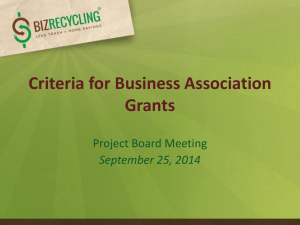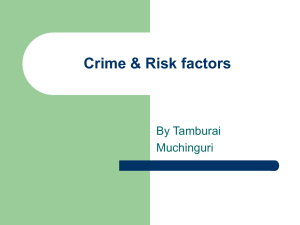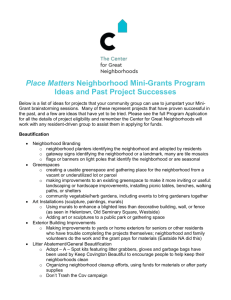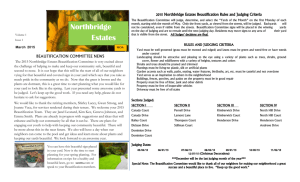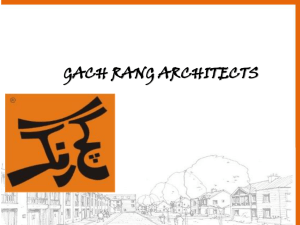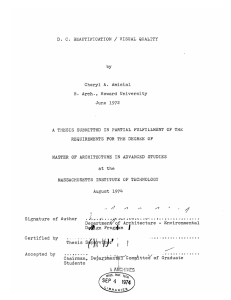Social Enterprise Advancing Sustainable Community Development
advertisement
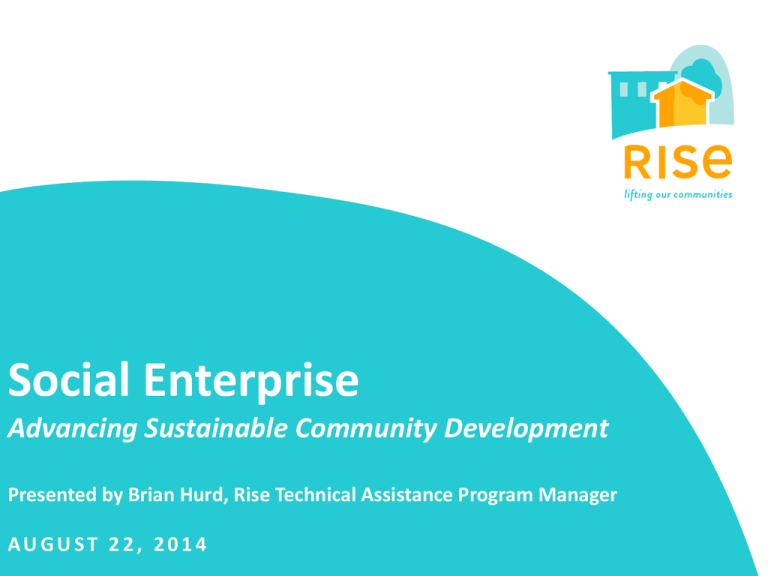
Social Enterprise Advancing Sustainable Community Development Presented by Brian Hurd, Rise Technical Assistance Program Manager AUGUST 22, 2014 RISE’S M I SSI ON Work in partnership with community-based and other organizations to redevelop and strengthen neighborhoods and communities. PRESENTERS & SPEAKERS Exploring the Relationship Between Social Enterprise & Sustainable Community Development Brian Hurd (Rise, Technical Assistance Program Manager) Jubilee Services - Jeffrey Holtzman and Thomas Maxwell (Jubilee Christian Development Corp.) Sweet Sensations, Inc. - Phil Minden (Sterling Bank, Vice President) Employment Legal Issues - Dana Malkus (Saint Louis University Assistant Law Professor & Supervisor of Community and Economic Development at Saint Louis University Law Clinic) Angel Baked Cookies – Father Gary Meier (North Grand Neighborhood Services) Sweet Potato Project – Sylvester Brown (North Area Community Development Corp.) Social Enterprise Business Development - Matt Nordmann (Director of Community Development for IFF, Inc.) Socially Responsible Investment Causes - Jake Barnett and Daniel Conner (Morgan Stanley & Company, Inc.) PURPOSE • Examine entrepreneurship and enterprise generation as a key foundation of sustainable community development of both economic and social capital in urban core communities, as well as individual self‐sufficiency and community empowerment. • Explore of entrepreneurship with an imperative to drive social change and build sustainable ventures. GROUP TRAINING SEMINAR OBJECTIVES • Understanding the role of enterprise development in poverty reduction • Identifying key elements to designing a successful social venture • Analyzing social entrepreneurship in the context of developing sustainable businesses • Networking with resource organizations for social enterprise development projects SOCIAL ENTERPRISE AND S U STA I N A B L E C O M M U N I T Y D E V E LO P M E N T Brian Hurd Technical Assistance Program Manager SOCIAL ENTERPRISE AND S U S TA I N A B L E C O M M U N I T Y D E V E L O P M E N T What do we mean by the term “Sustainable Community Development”? The process by which public, private, and community based stakeholders work to meet the needs of current and future generations. It does so in a manner that meets economic, environmental and social needs as mutually supportive outcomes; reflects the community’s unique history and assets; and evolves as the character of the community changes, priorities shift, and new challenges and aspirations are defined. - American Planning Association SOCIAL ENTERPRISE AND S U S TA I N A B L E C O M M U N I T Y D E V E L O P M E N T Nexus of Social Enterprise and Sustainable Community Development – Ex. Environmental Issues • Approx. 30% of waste in landfills is organic waste creating green house emissions as it is biodegrading (and leads to groundwater problems). • U.S. wastes 40% of edible food. Recycling Opportunities – • Composting • Renewable energy SOCIAL ENTERPRISE AND S U S TA I N A B L E C O M M U N I T Y D E V E L O P M E N T What is a Social Enterprise? An entity that applies commercial strategies and business-like activities to maximize improvements in the common good rather than maximizing profits for shareholders and owners. Characteristics – • Social enterprises are distinctive because their purpose is absolutely central to what they do - their profits are reinvested to sustain and further their mission for positive change. • What makes a social enterprise different from commercial enterprises is that it places a firm emphasis on tackling social problems. This positive impact is as important to its business objective as any financial bottom line. SOCIAL ENTERPRISE AND S U S TA I N A B L E C O M M U N I T Y D E V E L O P M E N T Social Enterprise Commercial Enterprise Motives Appeal to common good Appeal to self-interest Methods Mission-driven Market-driven Social value creation Economic value creation Directed toward mission activities Distributed to shareholders and owners Goals Destination of Income/Profit SOCIAL ENTERPRISE AND S U S TA I N A B L E C O M M U N I T Y D E V E L O P M E N T Social enterprises are motivated by the social value more than the financial return on investment. SOCIAL ENTERPRISE AND S U S TA I N A B L E C O M M U N I T Y D E V E L O P M E N T SOCIAL ENTERPRISE AND S U S TA I N A B L E C O M M U N I T Y D E V E L O P M E N T Social enterprises can be structured as: • a not-for-profit that carries on activities to generate revenue (ex. Hamilton Heights Neighborhood Organization, Inc. management of its properties) • a business with specific community-based objectives (ex. DeSales Community Housing Corporation’s affiliate Fox Grove Management, Inc.) • a program or venture that fulfills a social purpose (ex. Riverview West Florissant Development Corporation’s Neighborhood Beautification and Summer Youth Employment Program) SOCIAL ENTERPRISE AND S U S TA I N A B L E C O M M U N I T Y D E V E L O P M E N T Social enterprise leverage • Produce direct, measurable public benefits. A classic employment-focused social enterprise, for example, might serve at least four public aims: • Fiscal responsibility — It can reduce the various costs of public support for people facing barriers, by providing a pathway to economic self-sufficiency for those it employs. • Public safety — It can make the community in which it operates safer, by disrupting cycles of poverty, crime, incarceration, chemical dependency and homelessness. • Economic opportunity — It can improve the pool of human capital to create jobs in communities in need of economic renewal. • Social justice — It can provide a chance for those most in need. SOCIAL ENTERPRISE AND S U S TA I N A B L E C O M M U N I T Y D E V E L O P M E N T Social enterprise leverage – National Example Clean Street Team (CST) Cleaning Services, a social enterprise employment and training program offered by the Atlanta Center for Self Sufficiency (ACSS) • A full-service nonprofit that provides professional cleaning services, street maintenance and beautification. • Their mission is to provide businesses with a socially responsible alternative to other commercial janitorial cleaning service companies. • Organization engages homeless men and women, many of whom are military veterans, to work on various commercial cleaning and beautification projects throughout metro Atlanta. • Clients include Georgia Governor’s mansion, City of Atlanta, Inman Park Neighborhood Association, MARTA (transportation), Southstar CDC and others. • CST members receive weekly stipends and attend semi-weekly employment readiness workshops while actively seeking full-time employment and remaining drug-free. Eighty percent of participants transition to full-time employment within 12 months. SOCIAL ENTERPRISE AND S U S TA I N A B L E C O M M U N I T Y D E V E L O P M E N T THREE REASONS FOR STARTING A SOCIAL ENTERPRISE? A Sustainable Community Development Perspective 1. To meet a need in the community or local market not met through traditional business models 2. Advance or achieve a specific social mission 3. For a non-profit organization, contribute to its financial sustainability SOCIAL ENTERPRISE AND S U S TA I N A B L E C O M M U N I T Y D E V E L O P M E N T NEED IN THE COMMUNITY SOCIAL ENTERPRISE AND S U S TA I N A B L E C O M M U N I T Y D E V E L O P M E N T ADVANCING SOCIAL CHANGE The City of St. Louis’ Sustainability Mission Statement: Harness the strength and spirit of its diverse community to create an economically, socially and ecologically vibrant City for present and future generations -- one that dynamically serves those who live, work, and play in the City’s rich and celebrated historic landscape. SOCIALENTERPRISE AND S U S TA I N A B L E C O M M U N I T Y D E V E L O P M E N T FINANCIAL SUSTAINABILITY Social enterprise is a means to achieve sustainability through earned income, which leads to: • Income Diversification - Reducing the need for grants and government funding sources; • Financial Self-Sufficiency - Providing a more reliable, diversified funding base; or • Cost Savings and Resource Maximization - Enhancing the quality of programmatic services and reducing administrative costs SOCIAL ENTERPRISE AND S U S TA I N A B L E C O M M U N I T Y D E V E L O P M E N T PLANNING A SOCIAL ENTERPRISE, FIVE KEY STEPS A Sustainable Community Development Perspective 1 2 3 4 5 • Assess Organization • Identify Opportunities • Feasibility Study • Create Business Plan • Measure Impact SOCIALENTERPRISE AND S U S TA I N A B L E C O M M U N I T Y D E V E L O P M E N T FEASIBILITY & FINANCIAL SUSTAINABILITY – GOVERNMENT FUNDING TREND COMMUNITY DEVELOPMENT BLOCK GRANT PROGRAM HOME INVESTMENT PARTNERSHIP PROGRAM $3.99 Billion $1.825 Billion FY 2010 FY 2010 $3.34 Billion $1.607 Billion FY 2011 FY 2011 $2.94 Billion $1 Billion FY 2012 FY 2012 $2.94 Billion $1 Billion FY 2013 FY 2013 HUD Appropriations FY 2010 – 2013 MEASURING SUCCESS OUTCOMES: ACTIVITIES VS RESULTS • Conducting an activity is NOT the same as achieving desired results – although both are important • Studying (activity) for five hours (output) is NOT the same as understanding a subject (outcome) well enough to pass a test (measure) • Outcomes should be related to the initial needs identified A BASIC LOGIC MODEL Inputs What resources do you have to bring to a social enterprise activity? Financial resources, staff capacity, etc.? Activities What are you planning to do? What are the social enterprise venture’s primary activities? Outputs (Results that can be measured) -Did you implement your planned activities? How many persons, households, or housing units did you serve? Were you efficient? Outcomes Changes to systems - What would have happened anyway? = IMPACT Economic, Environmental and Social SOCIAL ENTERPRISE AND S U S TA I N A B L E C O M M U N I T Y D E V E L O P M E N T Basic Logic Model - Local Case Study Riverview West Florissant Development Corp. (RWFDC) is a 501(c) 3 organization with the mission of undertaking community development activities that include housing, neighborhood improvement along with and economic development in the targeted communities of Baden, College Hill, Near North Riverfront, North Riverfront, O'Fallon, Walnut Park East, Walnut Park West, and North Pointe. • RWFDC’s Neighborhood Beautification Program was launched in 2009 based on the organization’s five-year organizational strategic plan adopted in 2006. The strategic planning process was facilitated by Rise. • Overarching purpose for RWFDC’s Neighborhood Beautification Program include: Working with residents by providing lawn care maintenance (grass cutting, light painting, exterior cosmetics of property) to ensure an attractive and aesthetically pleasing community in addition to encouraging responsible property upkeep by working with homeowners and other property owners Creating summer employment opportunities each year for approximately 50-75 youth in addition to hiring adult non-violent ex-offenders to serve as supervisors and mentors A BASIC LOGIC MODEL RWFDC Neighborhood Beautification Program Inputs $120,000 ($100,000 CDBG + $20,000 Rise Collaborative Grant); existing staff person expanded duties; set-up data employment management and tracking system; business, insurance, and background check requirements, etc. Activities Neighborhood beautification services (landscaping, lawn maintenance, and light exterior painting) Outputs • • 50 youth hired during summer (# of jobs created in the nine neighborhoods) 100 yards serviced per week Outcomes • • • • • • • • Increased employment of those previously unemployed Obtaining jobs the following summer (transferability) Opening and retaining bank ccounts/increased financial literacy Graduation rates Youth-related crimes & recidivism rates Reduced code violations Reduced mowing costs for City’s Forestry Dept. And more A BASIC LOGIC MODEL RWFDC Neighborhood Beautification Program (Adjusting business model based on funding change) Inputs $120,000 $100,000 CDBG + $20,000 Rise Collaborative Grant; existing staff person expanded duties; set-up data employment management and tracking system; business and insurance requirements, etc.



